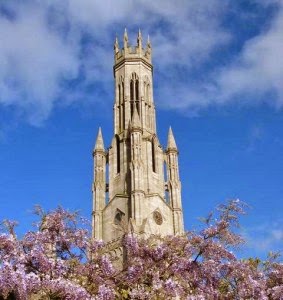The Carlow-Trails of Saints is made up of three separate driving routes which between them cover the entire county of Carlow and feature some 51 ecclesiastical attractions. Many of these sites are considered to be of national significance including the Romanesque doorway at Killeshin, the medieval cathedral at Old Leighlin and the monastic site at St. Mullins.
St. Patrick's Trail
Named after St. Patrick, who is reputed to have baptised the King of Leinster in north Carlow, this trail takes in the county's two largest urban settlements of Carlow and Tullow.
St. Laserian's Trail
A visit to one of Ireland's finest medieval churches. St. Laserian's Cathedral in Old Leighlin, make a perfect start to this trail which meanders through the heart of the county towards Myshall at the foot of the Blackstairs Mountains.
St. Moling's Trail
St. Moling, the seventh-century saint, ranks among 'the four great prophets of Ireland'. The monastery he founded at St. Mullins, beside the River Barrow, is the highlight on this train which bears his name.
Of course, you don't have to drive all three of these trails to get a good glimpse into the life and times of Ireland's saints. Here are a couple of the highlights that you may want to check out along your journey.
Romanesque Doorway of Killeshin
The present church was built in 1150 and is well worth visiting not just for its beautiful Romanesque doorway, one of the finest examples in the country, but for its scenic setting. You will find the church of Killeshin nestled in peaceful countryside, with wonderful views across the Barrow Valley to the Blackstairs Mountains.
Clonmore
Clonmore is one of Carlow's most important early Christian sites with a wealth of history for visitors to discover. The present road cuts through the monastery founded by St. Maedoc around 600 AD. No traces of the monastic buildings remain for the importance of the site is attested by the presence of two large crosses, nineteen cross-inscribed stones, an ogham stone and two bullaun stones.
St. Laserian's Cathedral and holy well
The picturesque village of Old Leighlin is home to one of Ireland's gems of late medieval architecture. St. Laserian's Cathedral was bult of the site of a monastery founded by St. Gobban c 600. The Cathedral features architecture from every century since it was built. The holy well which can be found 330 feet to the west of the church is dedicate to St. Molaise and features an early ringed cross said to denote the place where St. Laserian conversed with St. Finbar of Cork.
St. Brigid's Well
St. Brigid's Well is an ancient holy well that is now a modern shrine.
Cranavane Holy Well
Set in an untouched rural landscape, the holy well at Cranavane is closely associated with the early medieval Barragh church, the ruins of which lie close by. The church was linked with St. Finian who was born nearby in Myshall. It was the custom to dip coffins in the water of the well before burial in Barragh graveyard. The waters of the well are believed to cure a range of ailments including soreness of the eyes, pains and hurt limbs.
 St. Fortiarnan's Church
St. Fortiarnan's ChurchAgainst the backdrop of the Blackstairs Mountains stand the remains of this diminutive rectangular church which dates back to the tenth or eleventh century. It is a testament to the building skills of these early stone masons that all four walls are still intact almost one thousand years after they were first built.
St. Mullins - Ecclesiastical Ruins
Thus important monastery was founded by St. Moling in the seventh century. It has been a place of pilgrimage since the earliest of times and St. Moling's Well is still venerated for its powers of healing.
Graiguenamanagh
A popular boating center on the River Barrow whose character reflects a bygone time when the town was an important focal point for commercial boats. One of Ireland's finest Cistercian monasteries was founded here in 1204. It was called Duiske Abbey from the stream that flows nearby. The church was restored in 1974-80 and consists of a nave and chancel with an aisle on each side.
From pagan sites to ecclesiastical settlements; intricate layers of religious and secular cultural history set against rugged mountains, glorious countryside and lush river valleys make County Carlow a perfect base for exploring the Southeast of Ireland. Come explore the religious side of Co Carlow by exploring the Carlow-Trails of Saints. Start planning your religious tour of Ireland with Celtic Tours World Vacations.




No comments:
Post a Comment